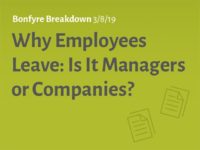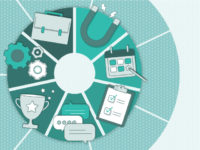Strong relationships within the workplace lay the foundation for success, especially between talent and upper management. Building and maintaining these relationships is crucial when attempting to improve employee engagement scores. Therefore, you must consider relationship-building strategies during the employee survey action planning process. Fostering relationships with every employee can seem challenging, maybe even unattainable. However, AI-powered coaching, automation, and other tools make building relationships seamless and (believe it not) more personalized than ever! Here are some tips for improving relationships so you can launch a successful staff survey action plan.
Schedule Regular, Meaningful Check-Ins
The power of regular check-ins in enhancing employee engagement is profound, especially for those who have shown signs of waning interest. Employees often disengage due to a sense of disconnect with the company’s goals, lack of recognition, unclear job roles, and scarce growth opportunities.
Regular check-ins serve as a vital touchpoint to tackle these concerns, making employees feel listened to, appreciated, and in tune with the company’s direction. Creating a culture that prizes open dialogue allows managers to pinpoint and address the roots of disengagement, boosting both productivity and satisfaction.
While regular check-ins are fundamental for fostering strong relationships within the workplace, they can sometimes run the risk of feeling unproductive, particularly if an employee feels they have nothing specific to say or contribute. This scenario can lead to meetings that seem to occur merely for their own sake rather than serving a purposeful end.
To circumvent this, it’s crucial to approach these sessions with a plan in mind. By thoughtfully covering areas such as project progress, potential obstacles, and long-term career goals, you can gain valuable insight into both the professional and personal landscapes of your employees.
Moreover, leveraging tools like Bonfyre can provide a clearer view of what’s on the horizon for team members, including noteworthy milestones or forthcoming opportunities for development. This information can be instrumental in guiding the direction of conversation, ensuring that discussions are both relevant and meaningful.
Manage. Don’t Micromanage.
Micromanaging often comes from a place of concern or a need for control, but it can really damage trust and relationships with employees. Constant oversight can frustrate employees, limit their creativity, and break down trust, which are all essential for a productive and positive work environment. If employees think their managers don’t believe in their abilities, it hurts morale and makes it hard to maintain a good team spirit.
The concerns surrounding micromanaging are heightened in today’s hybrid and remote working environments. Remote workers want to feel trusted and empowered, not like they’re constantly being watched. However, with employees out of sight, it could be tempting for management members to want to check in a little too often in search of updates.
Instead of micromanaging, implement better communication strategies to greatly improve employee satisfaction while giving yourself peace of mind. Have open discussions about expectations and goals. Provide consistent feedback and foster a supportive environment for employees.
By guiding rather than controlling, you can promote problem-solving and task ownership. In turn, employees feel empowered. This method not only enhances productivity but also morale, as employees appreciate feeling valued and supported.
Integrate Team Building Activities
Team building activities are key to boosting relationships and morale at work. As upper management, when you organize these events, you’re directly helping employees connect with their colleagues. Whether virtual or in-person, these gatherings allow team members to pause their routine tasks and bond in a relaxed, personal atmosphere.
Learning about each other’s backgrounds and experiences deepens empathy and understanding, strengthening connections. Use Bonfyre to encourage team members to share favorite memories, a funny childhood photo or their favorite summertime activity. This enhanced rapport leads to a positive, unified work environment where collaboration thrives.
Encourage Leadership Accessibility and Mentorship
Inviting leaders to join the employee survey action planning process is crucial for proper execution. Leaders shape the engagement atmosphere. When leaders actively participate, it signals to employees that their input is valuable and can drive change.
Encouraging leadership involvement is essential, but equipping them with the right tools and training to address feedback from surveys is paramount. Being approachable and ready for conversation helps bridge the gap between management and staff, leading to a more cohesive and driven team. This openness builds trust, encouraging employees to share their thoughts and ideas freely.
Mentorship programs, especially for peers and mid-level managers, are vital in cultivating an engaging culture. They bridge different organizational tiers, enhancing rapport and the exchange of ideas.
This knowledge flow enriches everyone, giving leaders insight into team hurdles and goals, which allows them to tailor their leadership approach more effectively. For employees, having direct access to leaders and mentors opens doors to growth, making them feel appreciated and seen.
Create a Path to Success Together
Goal setting plays a vital role in fostering meaningful relationships between employers and employees. By understanding and aligning with each employee’s personal and professional aspirations, managers can demonstrate genuine support and commitment to their team members’ success. When employees feel supported in their ambitions, they are more likely to feel challenged and appreciated, contributing to a positive and motivating work environment.
Setting goals together strengthens the bond between employer and employee, as it requires open communication, mutual trust, and a shared vision for the future. Moreover, achieving these goals becomes a shared success, reinforcing the sense of teamwork and collective achievement.
This process involves not just identifying end goals but also mapping out a clear path to achieve them, offering guidance, resources, and encouragement along the way.
Creating learning and development opportunities is vital for this initiative to be successful. Employees who see a future with the company are more likely to feel valued and invested in their work. Investing in talent development enhances the skill set within the organization while also signaling to employees that the company is committed to their long-term success and well-being.
Shine a Spotlight On Their Achievements
Recognition goes beyond mere acknowledgment. It fosters a positive work environment that strengthens their connection to the organization and their peers.
According to Gallup, proper recognition protocols can save a business that employs 10,000 employees up to $16.1 million annually in savings associated with turnover rates.
Rewards and recognition play a pivotal role in relationship-building in the workplace. They serve as tangible expressions of appreciation, showing employees that their hard work does not go unnoticed.
This practice encourages a cycle of positive reinforcement, where recognized behavior is likely to be repeated, and others are motivated to achieve similar acknowledgment.
Bonfyre is revolutionizing the way organizations reward and recognize their employees. By integrating with platforms like Microsoft Teams and utilizing KPIs, machine learning, and predictive analytics, Bonfyre offers AI-powered nudges to encourage timely and personalized recognition.
With over 1,000 reward options, it makes choosing the perfect way to say “thank you” or “well done” both easy and meaningful. Moreover, Bonfyre’s celebrations wall provides a dedicated space for acknowledging employees’ hard work, milestones, and achievements.
You can also tag other team members to join in on the celebration, including leadership. This level of engagement and personalized acknowledgment can significantly enhance leadership’s relationship with employees. Through rewards and recognition, everyone feels like a valued part of the team, which will drive overall engagement scores upward.
Embrace Flexible Work Arrangements
Actions speak louder than words when it comes to building strong relationships with employees. The shift toward prioritizing work-life balance and personal well-being has led employees to seek out hybrid and remote working opportunities.
These options allow them the flexibility to set their own hours as long as they complete their tasks. By offering such flexibility, organizations show a real commitment to meeting their employees’ diverse needs, which fosters a culture of trust and respect. This demonstrates to employees that their employers are responsive and willing to adapt to support them.
Flexible work arrangements are crucial for supporting employees in managing their responsibilities flexibly and autonomously. However, this freedom operates within a framework of clear expectations about deadlines and ongoing tasks.
Transparent objectives and open communication ensure that flexibility does not compromise productivity. Providing structure while allowing employees to adjust their schedules offers them the best of both worlds. In doing so, organizations not only boost employee satisfaction and retention but also improve overall performance.
Personalize Future Onboarding Processes
Employee engagement is a perpetual journey enriched and shaped by every piece of feedback and every learned experience. This ongoing process highlights the importance of using engagement survey insights to cultivate a better work environment for present staff and refine the onboarding experience for future team members. Such a proactive stance ensures that newcomers feel immediately welcomed, valued, and comprehended.
A good onboarding experience lays down a positive groundwork for their time with the company. Making this introduction as informative, engaging, and supportive as possible is crucial.
By weaving insights gained from engagement surveys into the onboarding framework, the experience can be tailored to meet the unique needs and expectations of incoming hires. For example, if the desire for increased mentorship opportunities emerges from survey data, integrating a mentorship initiative at the onboarding stage can effectively address this need from the outset.
By thoughtfully refining the onboarding process with insights from employee feedback, organizations can cultivate a workplace that not only boosts satisfaction and retention among its current workforce but also lays a solid foundation for new employees to prosper and succeed. This approach not only enriches the individual employee’s experience but also strengthens the overall organizational culture, making it a win-win for everyone involved.
Using AI for Employee Survey Action Planning
AI-powered coaching is revolutionizing the way relationships are built and maintained in the professional environment. By leveraging artificial intelligence, organizations can automate numerous processes that facilitate closer connections and more meaningful interactions.
For instance, AI can be programmed to send reminders to upper management about scheduling periodic check-ins for any direct reports with whom no recurring 1:1 is scheduled. This ensures that no significant milestones or opportunities for engagement are missed.
These automated systems can also track projects and achievements, providing a basis for recognizing and celebrating employee efforts and successes. By automating these tasks, AI allows managers to focus more on the quality of interactions rather than the logistics of organizing them.
In addition, AI can help personalize the employee experience by learning from interactions, feedback, and preferences to suggest activities, discussions, or learning opportunities that are most relevant and engaging to each team member. It can automate the distribution of surveys or gather feedback, enabling leaders to stay attuned to the team’s morale and engagement levels continuously. This level of customization and attention helps employees feel valued and understood, fostering a stronger sense of belonging and community within the organization.
Making AI work for you through platforms like Bonfyre not only streamlines administrative tasks but also opens up new avenues for enhancing interpersonal relationships at work and a more focused approach to relationship building.
Leaders can leverage these insights and reminders to take proactive steps in strengthening connections, ensuring that every team member feels recognized and supported. In this way, AI-powered coaching doesn’t replace the human element. Instead, it enriches relationships, making every interaction more impactful.









